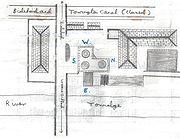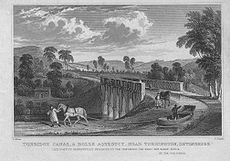
Annery kiln
Encyclopedia

Bideford
Bideford is a small port town on the estuary of the River Torridge in north Devon, south-west England. It is also the main town of the Torridge local government district.-History:...
to Great Torrington
Great Torrington
Great Torrington is a small market town in the north of Devon, England. Parts of it are sited on high ground with steep drops down to the River Torridge below...
, near Weare Giffard in the Torridge
Torridge
Torridge is a local government district in Devon, England. Its council is based in Bideford. Other towns and villages in the district include Holsworthy, Great Torrington, Hartland and Westward Ho!. The Island of Lundy is administratively part of the District...
District of North Devon
North Devon
North Devon is the northern part of the English county of Devon. It is also the name of a local government district in Devon. Its council is based in Barnstaple. Other towns and villages in the North Devon District include Braunton, Fremington, Ilfracombe, Instow, South Molton, Lynton and Lynmouth...
, England. The old lime kiln overlooks the River Torridge
River Torridge
The River Torridge is a river in Devon in England. It was the home of Tarka the Otter in Henry Williamson's book. The Torridge local government district is named after the river....
and lies close to the old 1827 canal and also to the railway that ran from Bideford to Torrington, opened in 1872 and closed in 1966. The old trackbed now forms a stretch of the Tarka Trail
Tarka Trail
The Tarka Trail is a series of footpaths and cyclepaths around north Devon, England that follow the route taken by Tarka the Otter in the book of that name. It is a figure-of-eight route, based on Barnstaple, and covers some of path....
. Annery is a small settlement nearby.
The history of Annery limekiln
Weare Giffard is situated near the tidal limit of the River Torridge, and coal and limestone had been brought up by boat for a long time previous to the building of the Rolle CanalRolle Canal
The Rolle Canal in North Devon, England runs 6 miles from Landcross, where it joins the River Torridge, to the limekilns at Rosemoor...
or Torrington, in 1823 - 1827. Culm
Culm
Culm, in botanical context, originally referred to a stem of any type of plant. It is derived from the Latin word for 'stalk' and now specifically refers to the above-ground or aerial stems of grasses and sedges....
, a form of imperfect Anthracite, was mined in Devon at Tavistock and Chittlehampton
Chittlehampton
Chittlehampton is a village and civil parish in the North Devon district of Devon in England. According to the 2001 census, the parish had a population of 820....
as well as being imported from South Wales. The limestone largely came from Caldey Island
Caldey Island
Caldey Island lies south of Tenby in Pembrokeshire, Wales.The island is home to a small village, but is best known for its monastery. Caldey Island is separated from the mainland by the Caldey Sound which is 1 km to 2 km wide between Caldey Island and the coast of Pembrokeshire...
off the South Wales coast, although Devon had quarries in Landkey
Landkey
Landkey is a small village in the county of Devon in the south-west of England with a population of 2274. It is situated from the nearest town of Barnstaple.-Origin:...
, Swimbridge
Swimbridge
Swimbridge is a village in the English county of Devon. It is situated south-east of Barnstaple and twinned with the town of St.Honorine Du Fay in Normandy, France. The name Swimbridge originates from the clegyman Sawin Birige. Sawin was a founder of a chapelry at Swymbridge in Saxon times...
, Filleigh
Filleigh
Filleigh is a small village in North Devon, on the southern edge of Exmoor.Castle Hill is a privately owned Palladian House built in 1730 by Hugh Fortescue, Lord Clinton, as his family home...
, South Molton
South Molton
"Molton" redirects here. Or see Molten or Moulton.South Molton is a small town in Devon, England. It is part of the North Devon local government district. The town is on the River Mole. According to the 2001 census the civil parish of South Molton had a population of 4,093.The town was one of...
and Combe Martin
Combe Martin
Combe Martin is a village and civil parish on the North Devon coast about east of Ilfracombe. It is a small seaside resort with a sheltered cove on the edge of the Exmoor National Park...
.

Calcium oxide
Calcium oxide , commonly known as quicklime or burnt lime, is a widely used chemical compound. It is a white, caustic, alkaline crystalline solid at room temperature....
from the kiln, to produce the slaked lime, hydrated lime, or pickling lime; several cottages for the lime-burners (although the main set of cottages are neither evidenced on any maps nor in census returns until after 1851, indicating that they were not built until later and only one census return in the 19th century lists one lime-kiln worker), shipbuilders and blacksmiths, etc. and storage buildings. A small wharf of sorts on the river allowed for the unloading of sailing barges.
Annery limekiln has a ramp facing the river, three kilns or burning 'pots', seven entrance doorways and nine lower apertures for the removal of the calcined limestone; the arrangement of the kilns gives an L-shaped compact structure. Some of the entrances led to arched lobbies or 'eyes', at the back of which were the grates and separate 'poking holes' to insert metals rods for 'working' the charge and helping aeration. A 'lean-to' slated roof may have slotted beneath part of the drip course of projecting stones, which runs around the kilns exterior walls. The arched entrances to the kiln also allowed for the safe collection of the quicklime, which reacted violently to water.
The top of the kilns was flat and large enough to allow for some storage of culm and limestone. Like the kilns at Torrington they were originally crenellated with castle-like battlements, an eccentric feature probably added by Lord Rolle
John Rolle, 1st Baron Rolle
John Rolle, 1st Baron Rolle was a British peer who had served as a Member of Parliament in general support of William Pitt the Younger and was later an active member of the House of Lords...
, who was colonel of the South Devon Militia and the South Devon Yeomanry
Yeomanry
Yeomanry is a designation used by a number of units or sub-units of the British Territorial Army, descended from volunteer cavalry regiments. Today, Yeomanry units may serve in a variety of different military roles.-History:...
. The original Annery kiln had been built prior to Lord Rolles's canal and the Great Torrington lime kilns; it is unlikely to have had the crenellations.

Gothic Revival architecture
The Gothic Revival is an architectural movement that began in the 1740s in England...
arches formed from bricks. The now lost crenellated 'battlements' construction was similar to other kilns such as those at Yeo Vale on the Torridge, south-west of Bideford and those at Torrington.
The evidence suggests that the original kiln had a single pot and arched entrances leading to three 'eyes', later two more pots were built with rounded tops to the arches which led to only two eyes each. The decorative front of the new kiln has blind arch
Blind arch
A blind arch is an arch found in the wall of a building which has been infilled with solid construction so it cannot serve as a passageway, door, or window. The term is most often associated with masonry wall construction, but is also found in other types of construction such as light frame...
es at either end and two quatrefoil
Quatrefoil
The word quatrefoil etymologically means "four leaves", and applies to general four-lobed shapes in various contexts.-In heraldry:In heraldic terminology, a quatrefoil is a representation of a flower with four petals, or a leaf with four leaflets . It is sometimes shown "slipped", i.e. with an...
s, which are a symmetrical shape which forms the overall outline of four partially-overlapping circles of the same diameter.
Being next to the river, the canal, and the road to Bideford and Torrington as well as the Weare Giffard Bridge across the Torridge, the kiln had excellent communications.
In Devon the demand for agricultural lime in the 19th century was very high, and farmers were forced to collect loads of lime from Annery, by pack-horse at first and later using wagons, arriving as early as 4am to ensure that they had a supply for the day.
The development of the rail network
History of rail transport in Great Britain
The railway system of Great Britain, the principal territory of the United Kingdom, is the oldest in the world. The system was originally built as a patchwork of local rail links operated by small private railway companies. These isolated links developed during the railway boom of the 1840s into a...
made local small-scale kilns generally unprofitable, but Annery closed in around 1864, before the local railway was opened. Local competition from the lime kilns at Torrington and elsewhere would have been intense.
Limekiln drawings gallery
Drawings produced in 1971. The measurements are only approximate.Function

Rolle Canal
The Rolle Canal in North Devon, England runs 6 miles from Landcross, where it joins the River Torridge, to the limekilns at Rosemoor...
, were hauled up the single ramp and emptied into the kiln chamber. Successive dome-shaped layers of culm coal and limestone would have been built up in the kiln on grate bars across the eye at the base. When loading or 'charging' was completed, the kiln would have been kindled at the bottom, and the fire gradually allowed to spread upwards through the charge. When burnt through, the lime was cooled and raked out through the base.
The size of kilns was limited by the need to allow air to permeate freely and to prevent a collapse from too much weight; this explains why individual kilns were all much the same size and therefore multiple kilns— three at Annery— were necessary to increase production. Each kiln usually made between 25 and 30 tonnes of lime in a batch; at Annery they may have been fired in rotation to ensure a continuous supply.
Typically each kiln took around a day to load, three days to fire, two days to cool and a day to unload. The degree of burning was controlled by trial and error from batch to batch by varying the amount of fuel used. There were large temperature differences between the center of a charge and the material close to the wall, so a mixture of under-burned, well-burned and dead-burned lime was normally produced. Typical fuel efficiency was low and the job was labour intensive, with a loading gang and an unloading gang who would work the kilns in rotation through the week. The heat was intense and the smoke considerable, making this a very dangerous occupation.
Lime and its uses

Calcination
Calcination is a thermal treatment process applied to ores and other solid materials to bring about a thermal decomposition, phase transition, or removal of a volatile fraction. The calcination process normally takes place at temperatures below the melting point of the product materials...
limestone
Limestone
Limestone is a sedimentary rock composed largely of the minerals calcite and aragonite, which are different crystal forms of calcium carbonate . Many limestones are composed from skeletal fragments of marine organisms such as coral or foraminifera....
. The reaction involved takes place at around 900°C, but a temperature around 1000°C is usually used to make the reaction proceed more quickly. Excessive temperature is avoided because it produces unreactive or "dead-burned" lime.
Lime is used in building as a mortars
Mortar (masonry)
Mortar is a workable paste used to bind construction blocks together and fill the gaps between them. The blocks may be stone, brick, cinder blocks, etc. Mortar becomes hard when it sets, resulting in a rigid aggregate structure. Modern mortars are typically made from a mixture of sand, a binder...
and also as a stabilizer in mud renders and floors. Lime is much used in agriculture
Agriculture
Agriculture is the cultivation of animals, plants, fungi and other life forms for food, fiber, and other products used to sustain life. Agriculture was the key implement in the rise of sedentary human civilization, whereby farming of domesticated species created food surpluses that nurtured the...
, but it only became widely possible when the use of coal made it cheaper.
Land transportation of bulky minerals like limestone and coal was difficult in the pre-industrial era due to the poor condition of the roads, so they were distributed by sea; the lime most often being manufactured at small coastal ports and then taken inland by carts. Many of the surviving kilns are still to be seen on quaysides around the coastline of the United Kingdom.
History of Annery and Weare Giffard
Annery is a small settlement nearby. Old maps show that a country house of that name existed there in the 18th century. Another lime kiln existed opposite Weare Giffard and the name was either used to distinguish the two or Annery may have been the manorial kiln which supplied the tenants.During a visit to Annery Kiln in 1971 one of the old cottages had a chimney fire. The householder sorted the problem out by firing both barrels of a 12 bore shotgun up the offending chimney, extinguishing the fire whilst at the same time 'cleaning the chimney!'
In the 1970s the kiln was used as a garage and store (see photographs) and was a community in its own right, known as Annery Kiln.
The small shipyard that had existed at Annery was moved down to the sea lock when the canal was built.
William Tardrew of Annery was a share holder in the Rolle Canal Company and held lands along the length of the canal.
Adjacent to the Annery kiln is Brick Marsh, which was the site of the Devon or Annery Pottery.
The name of the village is variously written as Weare 'Giffard' or 'Gifford,' the former being more frequently used. The Giffard family are recorded as having been in the area since at least the year 1219. Annery was first recorded as 'Auri' in 1193.
The Beam Aqueduct (see illustration) has long been used as a road bridge to a private house and below it were filmed several pivotal scenes for the Tarka the Otter
Tarka the Otter
Tarka the Otter: His Joyful Water-Life and Death in the Country of the Two Rivers is a novel by Henry Williamson. The book narrates the experience of an otter. It was first published in 1927 by G.P. Putnam's Sons, with an introduction by the Hon. Sir John Fortescue, K.C.V.O..-Plot summary:The plot...
film.

